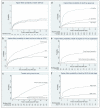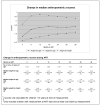Outcomes of the South African National Antiretroviral Treatment Programme for children: the IeDEA Southern Africa collaboration
- PMID: 20128272
- PMCID: PMC2925142
Outcomes of the South African National Antiretroviral Treatment Programme for children: the IeDEA Southern Africa collaboration
Abstract
Objectives: To assess paediatric antiretroviral treatment (ART) outcomes and their associations from a collaborative cohort representing 20% of the South African national treatment programme.
Design and setting: Multi-cohort study of 7 public sector paediatric ART programmes in Gauteng, Western Cape and KwaZulu-Natal provinces.
Subjects: ART-naive children (< or = 16 years) who commenced treatment with > or = 3 antiretroviral drugs before March 2008.
Outcome measures: Time to death or loss to follow-up were assessed using the Kaplan-Meier method. Associations between baseline characteristics and mortality were assessed with Cox proportional hazards models stratified by site. Immune status, virological suppression and growth were described in relation to duration of ART.
Results: The median (interquartile range) age of 6 078 children with 9 368 child-years of follow-up was 43 (15 - 83) months, with 29% being < 18 months. Most were severely ill at ART initiation. More than 75% of children were appropriately monitored at 6-monthly intervals with viral load suppression (< 400 copies/ml) being 80% or above throughout 36 months of treatment. Mortality and retention in care at 3 years were 7.7% (95% confidence interval 7.0 - 8.6%) and 81.4% (80.1 - 82.6%), respectively. Together with young age, all markers of disease severity (low weight-for-age z-score, high viral load, severe immune suppression, stage 3/4 disease and anaemia) were independently associated with mortality.
Conclusions: Dramatic clinical benefit for children accessing the national ART programme is demonstrated. Higher mortality in infants and those with advanced disease highlights the need for early diagnosis of HIV infection and commencement of ART.
Figures



References
-
- World Health Organization. UNICEF. UNAIDS Towards Universal Access: scaling up priority HIV/AIDS interventions in the health sector. WHO. [accessed 5 December 2008]. 2008. http://www.who.int/hiv/ mediacentre/2008progressreport/en/index.html.
-
- National Department of Health SA Progress report on declaration of commitment on HIV and AIDS. WHO. [accessed 24 February 2009]. 2008. http://data.unaids.org/pub/Report/2008/south_africa_2008_ country_progre....
-
- World Health Organization Report of the WHO Technical Reference Group, Paediatric HIV/ ART Care Guideline Meeting. WHO. [accessed 27 October 2008]. 2008. http://www.who.int/hiv/pub/meetingreports/ art_meeting_april2008/en/inde....
-
- Eley B, Davies M-A, Apolles P, et al. Antiretroviral treatment for children. S Afr Med J. 2006;96:988–993. - PubMed
-
- Jooste JP, Van Zyl AJM, Baker A, Crawford W, Jassen A. Antiretroviral treatment in the Northern Cape. S Afr Med J. 2008;95:812. - PubMed
Publication types
MeSH terms
Substances
Grants and funding
LinkOut - more resources
Full Text Sources
Medical
